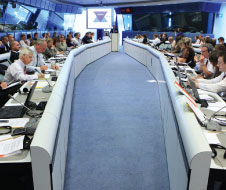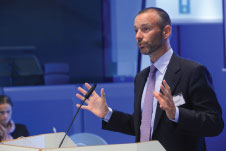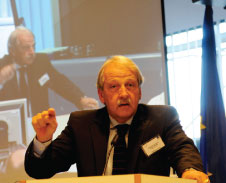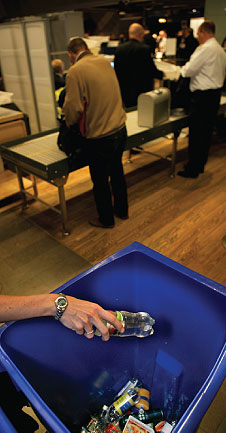
The High Level Conference on aviation security included sessions focused on ‘A global perspective to civil aviation security’, ‘Risk assessment in the EU’, and ‘Agenda for the future: Balancing facilitation and aviation security’.
The most talked about subject in relation to airport security – the restrictions on liquids, aerosols and gels – has been in place since November 2006, following the discovery in August of that year of a terrorist plot involving liquid explosives to be used on transatlantic flights departing the UK. Regular airport users and Airport Business readers will know that liquids may only be carried airside in individual containers no larger than 100ml, with all containers fitting in a transparent, re-sealable bag. Travellers arriving in the EU from a non-EU country airport and transferring to another flight, unless arriving from an approved airport – those with ‘third country recognition’ – are not allowed to carry LAGs exceeding 100ml on board their next flight, including duty free purchases sealed in secure tamper-evident bags (STEBs).
As previously detailed in these pages, the restrictions were to be removed in a two-phase process, with 29 April 2011 the initial deadline for the easing of LAGs restrictions for transfer passengers, with the second phase rolling out in April 2013. That first phase was intended to allow the carriage of LAGs purchased at non-EU airports by passengers transferring at European airports within 36 hours of purchase. However, the first phase failed to materialise because a significant number of Member States decided to retain the ban on LAGs from third countries, and the US stated that it would impose extra screening requirements on any flights bound for US destinations. The lack of agreement between the US and the EU coupled with the potential confusion of patchy implementation across Europe had the potential to cause even more confusion for passengers. As a result, the European Commission adopted revised legislation (Regulation (EC) 720/2011) removing the first phase completely and aiming for the full removal of the current restrictions in April 2013. The Regulation now states that the European Commission will work closely with all parties concerned and will assess the situation in respect of the screening of LAGs by July 2012.

ACI EUROPE Director General Olivier Jankovec addressed the High Level Conference on aviation security – ‘Protecting Civil Aviation Against Terrorism’, hosted by the European Commission and the Polish Presidency of the EU.
The industry position, ever since the introduction of the ban on LAGs, has been to support the efforts of the European Commission in order to allow the smooth return towards the situation that existed before summer 2006. However, ACI EUROPE has always based its support of the European Commission on two fundamental premises: security and facilitation. Any removal of the ban should be based on a sustainable technological solution that ensures a high degree of probability of detection of a wide range of liquid explosives. From a facilitation point of view, ACI EUROPE believes that any solution that allows the removal of the current ban should be passenger friendly and, therefore, enhance the passenger experience rather than complicate it any further.
ACI EUROPE is studying the implications of the removal of the ban in 2013 and it is coordinating the operational trials between EU Member States, airports and manufacturers across Europe. It has provided significant information on the operational and practical issues surrounding LAGs screening. For example, ACI EUROPE has raised concerns about the international situation, along with practical issues of tender and procurement procedures, and has stated that a decision regarding going ahead with the 2013 deadline needs to be made as early as possible in 2012.
Security Scanners
The other part of the airport security equation is Security Scanners, which have been in the news a lot these past months, in particular in relation to the US position on them. Here in Europe, there has been some positive progress on this.
A European Commission amending legislative proposal to include security scanners as an alternative means of screening was voted on by the Civil Aviation Security Regulatory Committee on 6 July. The amending legislation passed scrutiny by the European Parliament and Member States on 16 October. It was adopted on 11 and 12 November and should enter into force on 1 and 2 December. The key points in the amending legislation are:
- Backscatter ionising radiation security scanners are not allowed, except as part of an authorised trial;
- Passengers are entitled to opt out and be searched by an alternative method;
- Security scanners should move towards the use of automatic threat detection (ATD) to obviate the need for human screeners; and
- The use of security scanners is not mandatory.
Security Scanners are already in place at Amsterdam Airport Schiphol and Manchester Airport (under trial), while a number of other airports are also exploring the possibility of investing in this technology.
High Level Conference
The Polish Presidency of the EU (running from 1 July to 31 December this year) has been particularly active on transport. In the weeks following the 10th anniversary of the 9/11 Terrorist Attacks and in partnership with the European Commission, it hosted a High Level Conference on aviation security – ‘Protecting Civil Aviation Against Terrorism’ – in Brussels on 27 September. The event brought together more than 100 government representatives and industry stakeholders, including ACI EUROPE, AEA, ECAC, IATA, ICAO and the US Transportation Security Administration, to discuss developments in aviation security over the past decade.

Addressing the High Level Conference on aviation security, Matthias Ruete, Director General of the European Commission’s DG TREN, commented that “international cooperation is crucial for successfully combating terrorism and for keeping aviation running smoothly”.
In her opening remarks, Ambassador Beata Peksa-Krawiec, Polish representative to the EU’s Political and Security Committee, set the scene: “The terrorists continuously consider passenger and cargo aircraft as a weapon of choice. The persistent threat was confirmed by events such as the 2006 plot to defeat security checkpoint screening using liquid explosives, the use of non-metallic IED components concealed in the terrorist’s underwear on Christmas Day 2009, or the attempt to ship two explosive packages in cargo by concealing them in printer cartridges in October 2010. Common danger needs common solutions and an integrated approach.”
Matthias Ruete, Director General of the European Commission’s DG MOVE, followed with a keynote address, in which he said that “In civil aviation, Europe now has a robust and comprehensive security regime. It has shown its ability to respond to new threats, such as improvised liquid explosives in 2006; and to adapt to technological developments, such as security scanners – with a recent legal proposal to allow their use at EU airports.”

ACI EUROPE believes that any solution that allows the removal of the current ban on LAGs should be passenger friendly and, therefore, enhance the passenger experience.
Ruete also emphasised that no State is able to tackle terrorism alone and that “international cooperation is crucial for successfully combating terrorism and for keeping aviation running smoothly”.
The conference sessions focused on ‘A global perspective to civil aviation security’, ‘Risk assessment in the EU’, and ‘Agenda for the future: Balancing facilitation and aviation security’. ACI EUROPE Director General Olivier Jankovec participated in this third session, where he outlined the basic concepts underlying the joint ACI EUROPE and Association of European Airlines Better Security risk-based security project.
It was widely agreed that, 10 years on from 9/11, civil aviation is protected by a robust security regime. However, while, statistically, the threat posed to aviation remains relatively small, air travel continues to be an attractive, high visibility target for international terrorism. The conference participants discussed how to develop aviation security policy further, in order to efficiently address the evolving threat.
Participants agreed that the development of a common European risk assessment for cargo and mail security has been positive. Security measures can and should relate to the risk they intend to mitigate. If a high quality risk assessment is available, security resources can be targeted to where the risk is greater.
There was also agreement on the need for more efficient controls. Targeting controls on the basis of risk was considered one way of improving efficiency and the European Commission was invited to coordinate expert work examining this and other avenues for the future security model, involving regulators and stakeholders. The consensus was that more unpredictable measures should be considered in more areas of the security process.
Technological progress serves both security and facilitation. Reference was made to security scanners and the legislative proposal to allow their use at EU airports, improvements to liquid explosives detection systems, and biometric identification technologies. The conference concluded that the EU should continue to support initiatives aimed at developing new technology, particularly high-speed detection systems and those that allow a smoother throughput of passengers, baggage and cargo.
However, beyond the operational aspects and the technological progress, the fact remains that aviation is global, and so too is the threat. A proactive international agenda is, therefore, essential. Participants at the EU conference agreed on the need for robust global rules, through ICAO, to effectively address current threats.
With this in mind, ICAO’s own High Level Conference on Aviation Security is set to take place in September 2012. It should provide a welcome opportunity to move forward.







